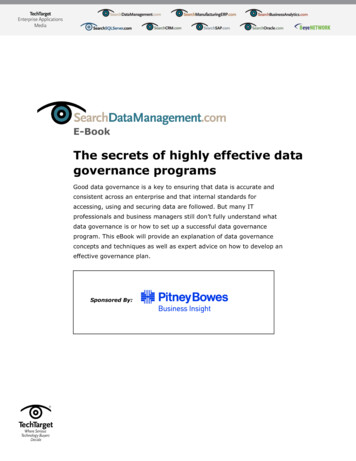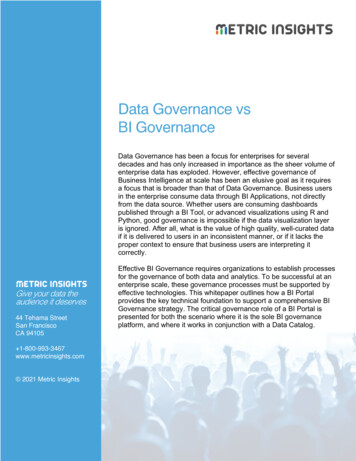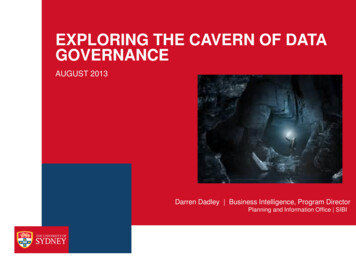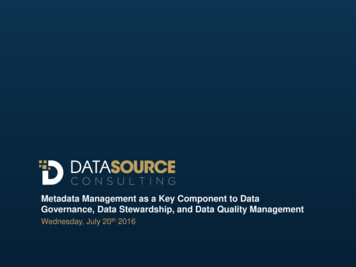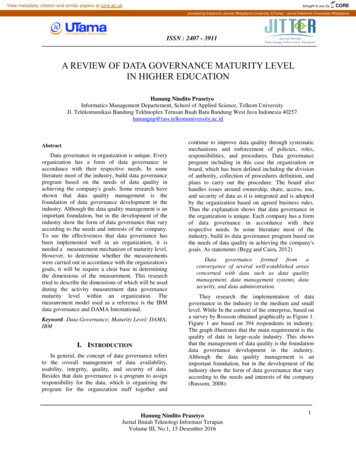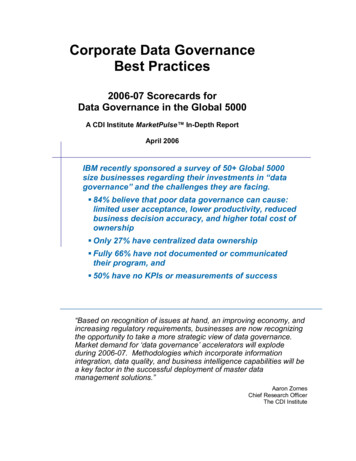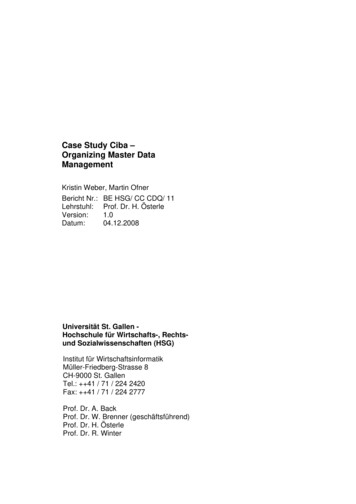
Transcription
Case Study Ciba –Organizing Master DataManagementKristin Weber, Martin OfnerBericht Nr.: BE HSG/ CC CDQ/ 11Lehrstuhl: Prof. Dr. H. ÖsterleVersion:1.0Datum:04.12.2008Universität St. Gallen Hochschule für Wirtschafts-, Rechtsund Sozialwissenschaften (HSG)Institut für WirtschaftsinformatikMüller-Friedberg-Strasse 8CH-9000 St. GallenTel.: 41 / 71 / 224 2420Fax: 41 / 71 / 224 2777Prof. Dr. A. BackProf. Dr. W. Brenner (geschäftsführend)Prof. Dr. H. ÖsterleProf. Dr. R. Winter
ContentsiiContents1Company .41.1Overview .41.2Structure .51.3Competitive Challenges .62Initial Situation .72.1Strategy .72.2Master Data Management Organization .72.3Data and System Landscape .92.4Pain Points.103“Enterprise” Project .113.1Goals .113.2Execution .123.3Challenges .163.4Change Management .173.5Critical Success Factors .1745New Solution .194.1Master Data Strategy .194.2Master Data and Processes.194.3Master Data Organization .234.3.1Data Ownership Model .244.3.2Stewardship Organization .254.3.3Maintenance Organization .264.3.4Master Data Governance .284.4Systems .294.5Cost and Benefits .314.6Planned Future Developments .33Conclusion .34Appendix A.Master Data Organization Roles.35Appendix B.Expert Interviews .36References .37 HSG / IWI / CC CDQ / 11
AbstractiiiAbstractCiba Inc. is a specialty chemical company based in Basel, Switzerland. Due toincreasing competitive challenges, Ciba set up a strategic program to increase cost‐effectiveness, improve efficiency, improve transparency, and foster profitablegrowth. One of the five key elements was the creation of a company‐wide systemstructure. A new global SAP system should allow for seamless integration of allbusiness processes from purchasing and production through to marketing, sales,and transport.As part of the “Enterprise” project, Ciba started a Master Data Management (MDM)initiative with the vision to consolidate master data across the company, to havestrict master data governance rules and responsibilities in place, to formalize masterdata maintenance processes and validations in order to ensure master data quality,and to document key objects in a central database repository.Six key principles set the top framework for master data and strengthen the dataquality awareness among master data stakeholders and users. The new MDMorganization consists of three closely interlinked parts: a business data ownershipmodel, a stewardship organization, and a maintenance organization. The maincharacteristic of master data governance at Ciba is the responsibility assignment byregion. Stewardship and maintenance roles are responsible for one specific region,sub‐region, country, or site across business segments, business processes, and dataobject types. The “Data Standards Team” department is located in the corporateheadquarters and provides master data services to the whole MDM community.Local and global workflows have been implemented to support master maintenanceprocesses. They support compliance with legal obligations and are one cornerstoneof proactive data quality management. Another cornerstone is the DST Life Cycle,which enables Ciba to define, measure, and improve master data quality on asustained basis. HSG / IWI / CC CDQ / 11
Company41 Company1.1OverviewCiba Inc. is a specialty chemicals company with nearly 14,000 employees. It createsproducts to improve the quality, functionality, and appearance of plastics, coatings,and paper. It helps to shield people and objects from UV light and creates color for avast array of materials. It also helps industries to recycle, clean, and save water, aswell as adding new qualities to materials, and enables progress in miniaturizingelectronic components. Ciba serves a number of markets in 120 countries, includingpaper, plastics, packaging, lubricants, automotive, construction, electronics, watertreatment, agriculture, and home & personal care industries. Ciba is a globalcompany with a significant presence in Europe and North America, and a strongposition in Asia. [cf. Ciba 2008a]Ciba Inc.Foundation1997, from the specialty chemical operations of the former Ciba‐Geigy Ltd.when that company merged with Sandoz to form NovartisHeadquarterBasel, SwitzerlandSectorSpecialty ChemicalsLines of Business Three market‐focused segments: Plastic Additives, Coating Effects, Water &/ DivisionsPaper TreatmentCorporateStructureThree segments, three regions, 63 production sites in 20 countries, six F 6.523 billion (2007, 3%)CHF 552 million (EBIT) (2007, 4%)Employees 14,000CustomersMajor markets in 120 countries: automotive, packaging, home & personal care,paper and printing, construction, electronics, water treatment, and agricultureindustriesTable 1‐1. Brief Profile of Ciba Inc. HSG / IWI / CC CDQ / 11
Company5Ciba has its roots in the first chemical company in Basel – J.R. Geigy – trading inchemicals and dyes (founded 1757). In 1859, the company started producing1dyestuff. In 1971, J.R. Geigy Ltd. merged with Ciba , a Basel‐based chemicalscompany founded in 1884, to form Ciba‐Geigy Ltd. Ciba‐Geigy Ltd. merged withthe pharmaceuticals company Sandoz in 1996 to form Novartis. The specialtychemicals divisions were spun off by Novartis and formed Ciba Specialty ChemicalsInc. in 1997. Since 2007, Ciba has operated under the name “Ciba Inc.”. [cf. Ciba2008b]1.2StructureCiba comprises of three business segments: Plastic Additives (33% of Ciba’s sales),Coating Effects (28%), and Water & Paper Treatment (39%). The business segmentsare responsible for marketing, research and development, technology, production,and sales [Ciba 2008a]. They enjoy a large degree of autonomy and are individuallymeasured. In addition, Ciba has a small number of business units offering nicheproducts and services. For example, Expert Services is Ciba’s consulting businessunit offering knowledge‐based services, such as regulatory consulting, andanalytical and material testing to Ciba’s customers [Ciba 2008c].Non‐core support functions are provided on a global basis by “Group Services”, acentralized service unit. Group Services includes IT, HR, Finance, GroupCommunications, Internal Audit, Law & Environment, and Business ProcessServices (BPS).Ciba has 63 manufacturing sites in 20 countries. One manufacturing site usuallyproduces for one business segment, sometimes for two segments. In some locationsCiba has dedicated commercial and distribution sites. Ciba is also regionallyorganized, distinguishing three major regions: NAFTA (North America), EMEA1Ciba is an abbreviation for “Gesellschaft für Chemische Industrie Basel”. HSG / IWI / CC CDQ / 11
Company6(Europe, Middle East, Africa), and APAC (Asia, Pacific). In 2008, Ciba is toconsolidate its research and development centers and is introducing six cross‐company research centers focusing on Ciba’s core technologies, such as Color, andPaper Strength and Coating [Ciba 2008a].1.3Competitive ChallengesThe specialty chemicals industry is a demanding and competitive industry. It suffersfrom exceptionally high raw material and energy costs, resulting in unfavorablebusiness conditions for Ciba and some of its customer industries. Pressure on salesprices continues, underlining the necessity for each product to add value for bothcustomers and shareholders. The pace of technological innovations remains rapid.Hence, market leadership depends on an ever faster transfer of discoveries intosaleable products. The geographic center of the industry is shifting, with major newopportunities appearing in Asia and the Middle East. [cf. Ciba 2008a] The maincompetitors of Ciba are companies like BASF, Dow, Lanxess and new companiesappearing in Asia.Laws and regulations impose increasing obligations. Ciba created a productdefinition concept to ensure a common understanding of a product definition acrossthe company. The product definition concept describes the composition of a productfrom various substances and their country of origin, and guarantees full compliancewith legal and regulatory requirements as well as traceability and auditability of aproduct throughout its life cycle. A new regulation in the European Union (EU) isREACH (Registration, Evaluation, Authorization and Restriction of Chemicals) thatcame into legal force in 2007. All chemicals produced in or imported into the EUmust comply with REACH. REACH requires major investment by the chemicalindustry, as companies must test and document the human and environmentalimpact of each of their chemicals. HSG / IWI / CC CDQ / 11
Initial Situation72 Initial Situation2.1StrategyDue to the outlined challenges, Ciba sees using its resources as effectively aspossible and making sure it supports its customers’ efficiency as the key to its futuresuccess. Operational excellence is therefore a strategic imperative for Ciba. In 2006, itstarted the “Operational Agenda”, a company‐wide program. The main goals of thisprogramwereto increase cost‐effectiveness, improveefficiency,improvetransparency, and foster profitable growth. The Operational Agenda comprises fivekey elements: Marketing & Sales, Innovation, Lean Manufacturing, GeographicalFootprint, and Company‐Wide System Structure. For example, as part of theMarketing & Sales initiative a new pricing model and a pricing tool wereintroduced, ensuring more consistency and allowing sales teams to analyze each salein comparison with others in the region. A new global SAP system has beenimplemented as part of the Company‐Wide System Structure initiative. The systemwill allow for seamless integration of all business processes from purchasing andproduction through to marketing, sales, and transport. [cf. Ciba 2008a]Compliance is another strategic goal for Ciba. Ciba has been involved in shaping thenew REACH regulation from the beginning. Ciba set up a multi‐disciplinary teammanaging the implementation of REACH throughout the company, and workingclosely with customers and suppliers. Through collaboration with customers,REACH also offers the opportunity to bring Ciba closer to the market. Ciba hasdeveloped an in‐depth understanding of REACH requirements so that Ciba ExpertServices can help customers to achieve compliance.2.2Master Data Management OrganizationSince its reorganization in 2000/2001, Ciba has had a dedicated, centralized MasterData Management (MDM) organization (cf. Figure 2‐1). Before the reorganization,each segment had its own Supply Chain Management (SCM) and IT organization. In HSG / IWI / CC CDQ / 11
Initial Situation8the new organization, MDM responsibility is vested in the new centralized SCMorganization. The focus of MDM was on material master data. The SCM employeespossessed the necessary domain knowledge about materials, such as products andLocalManufacturing SitesCentralSCM Organizationsubstances. Responsibility for customer and supplier master data was local.Global DataManagement &AdministrationRegional DataManager EMEARegional DataManager NAFTARegional DataManager APACLocal DataLocal DataManagerLocal DataManagerLocal DataLocal DataManagerLocal DataManagerLocal DataLocal DataManagerLocal DataManagerManagerManagerManagerFigure 2‐1: MDM Organization for Material Master Data (Initial Situation)The group Global Data Management & Administration had 2 ½ full‐time employees(FTEs). This group had worldwide responsibility for material master data. Itpossessed ownership for data definitions, i.e., it defined global standards formaterial master data, and decided on changes in their structure. It was alsoresponsible for operative master data processes and global master data projects.Three Regional Data Managers (a part‐time role) were also part of the SCMorganization. They were responsible for regional projects, and for monitoring andtraining Local Data Managers. One Regional Data Manager was assigned per regionNAFTA, EMEA, and APAC. Local Data Managers were responsible for master datamaintenance in both local (customers and materials) and global (materials) systems.Worldwide there were 60 part‐time Local Data Managers – one per manufacturingsite. Each Local Data Manager was assigned to one of the three Regional DataManagers. However, the Regional Data Managers did not have authority over Local HSG / IWI / CC CDQ / 11
Initial Situation9Data Managers, since Local Data Managers were not part of the MDM organization,but were assigned to a manufacturing site.2.3Data and System LandscapeCiba used the ERP system BPCS (Business Planning and Control System) developed2by System Software Associates . BPCS supported major business processes, such asFinancials, Planning, Distribution, and Manufacturing. Ciba had 60 local BPCSimplementations – one per manufacturing site. First BPCS implementations dateback to the 1970s. In 1996, all legacy ERP systems were substituted by BPCS. Overthe years, many BPCS add‐ons were developed or bought, making upgrades to newsoftware releases difficult or even impossible.BPCS systems were provided with material master data by a central master datarepository called Ciba Common Database (CCDB). The repository was developed in1996 with the goal of improving reporting across business lines. The Local DataManagers entered material master data into the repository. The data was thentransferred to the local BPCS implementations, still involving a lot of manual work.Materials received unique identifiers within the repository. Mapping tables wereused to map local identifiers with global identifiers. Material data could be changedin local systems, resulting in quite a few deviations. Global Data Management &Administration was mainly responsible for CCDB. The group created monthlyreports on deviations among the systems. Based on these reports, Regional andLocal Data Managers cleansed data in local BPCS systems and the global CCDB.Few attempts were made to centralize customer and supplier master data.Centralized customer identifiers were part of an in‐house e‐business platform calledmyBIZ. MyBIZ transferred the customer identifiers to local BPCS systems. Theintroduction of unique customer identifiers was accompanied by a clean‐up project2SSA was acquired by Infor Global Solutions in 2006 (www.infor.com). HSG / IWI / CC CDQ / 11
Initial Situation10to harmonize customer names and addresses. Similarly, the in‐house systemyourBIZ centralized supplier identifiers for chemical suppliers. The synchronizationbetween BPCS and yourBIZ was performed manually – the global identifier wascomplemented to local supplier master data in BPCS.2.4Pain PointsCiba was aware that bad master data quality may create problems in businessprocesses and had started centralization and harmonization initiatives. However,MDM organization and IT systems provided an inadequate response to newchallenges and requirements.Local BPCS systems allowed the creation and updates of (harmonized) materialmaster data. This resulted in deviations between the central repository and localsystems, and between local systems. Changes in master data could not be traced. Alot of data synchronization between systems was necessary. Master data operationsinvolved many manual activities, such as the time‐consuming maintenance ofmapping tables for master data identifiers. Bad search options in the centralrepository resulted in duplicate and multiple material master data: It was easier tocreate a new record than to search for an existing one.Material master data could be used in reports and business processes (e.g.,Planning), although local master data maintenance was not completed and hencelocal data was missing. This caused wrong reports and wrong calculations inPlanning. There was no formalized withdrawal process for materials and theirmaster data. Hence, materials that were no longer sold could still be on stock,causing unnecessary inventory costs.Master data documentation was scattered all over the company, including userscripts, business scenarios, and job guides in different formats and office documents.It was difficult to find the right information and to keep it up to date. HSG / IWI / CC CDQ / 11
Project “Enterprise”11Compliance with legal obligations was insufficiently supported by master dataprocesses. For example, SOX requires companies to formalize and documentprocesses, ensure adherence to the sequence, and define and guarantee3authorizations . Furthermore, the product definition concept (cf. 1.3) requires thecorrect description of the product composition.3 Project “Enterprise”“Enterprise” was Ciba’s project for implementing a company‐wide integrated ERPsystem infrastructure. Ciba decided to replace its legacy BPCS systems by an SAPERP 2005 system. The SAP implementation followed a single‐template approachwith a global roll‐out. The project started in the middle of 2005 and ended threeyears later in August 2008. Part of this project was an MDM initiative which is themain focus of this case study. The drivers of this initiative were Ciba’s CIO and theSAP Project Manager who were painfully aware of the consequences of bad masterdata quality from past experience.3.1GoalsThe goals of the SAP project can be delineated from the challenges Ciba faced andthe strategy of operational excellence it had set up to deal with these challenges.Essentially, the project was intended to increase cost‐effectiveness, improveefficiency, and improve transparency over systems and master data.The MDM vision was to consolidate master data across the company, to have strictmaster data governance rules and responsibilities in place, to formalize master datamaintenance processes and validations in order to ensure master data quality, andto document key objects in a central database repository.For the organizational structure, it was planned to apply data ownership to BusinessProcess Owners, to concentrate master data maintenance via dedicated roles on3In the meantime, Ciba delisted from NYSE, and is no longer obliged to follow SOX requirements. HSG / IWI / CC CDQ / 11
Project “Enterprise”12corporate and local levels (reduce the number of persons allowed to maintain masterdata), to prepare Local Data Managers for daily maintenance operations on localdata objects, to establish a Data Managers’ network, and to communicate andcoordinate between different stakeholders.Transparency over master data maintenance processes was a major goal due toobligations imposed by SOX or REACH. Earlier attempts to increase transparencyhave not been sufficient to support legal requirements. Therefore, the goals withrespect to master data maintenance processes were to standardize processes acrossregions, to formalize and support maintenance processes for critical data objects byworkflows (especially for materials), to provide services to the business in thecontext of master data (e.g., mass maintenance, data cleansing, data migrationprojects), to support the definition of data quality, and to support the efficiency ofsubsequent business transactions. Master data services, maintenance processes, anddata quality should be measured and monitored by Service Level Agreements(SLAs) and Key Performance Indicators (KPIs). Critical data objects should beappropriately documented from a technical and a business perspective in a centraldatabase repository which should be accessible via a web interface and maintainedin one place.3.2ExecutionDuring the first year of the project, global processes were designed, resulting in anSAP blueprint. The global SAP system was customized according to the blueprintbuilding the SAP template. The local SAP implementations were based on thistemplate, with minimal changes due to country‐specific requirements such as taxand other laws. SAP implementation started in the UK and Italy in November 2006.Every four to five months the next roll‐in of a set of countries to the global SAPsystem followed. Altogether the project encompassed five roll‐ins; the last one inAugust 2008 dealt with the APAC countries. HSG / IWI / CC CDQ / 11
Project “Enterprise”13The project team consisted of around 200 people, including approx. 100 externalconsultants. The project manager was dedicated full‐time to this project andreported directly to Ciba’s Board. The project team was split into 10 sub‐projectteams. One team was responsible for one main business process, such as Finance,Order to Cash, or Procurement. In addition, a Change Management team wasresponsible for documentation and training. The tasks of the dedicated MDM teamwere data preparations, migrations and cut‐over for the roll‐ins. All these projectteams have been supported by the line organization (e.g., IT department assistedwith architectural and authorization questions).The MDM team was separated from the Data Standards (DST) team, which wasresponsible for the preparation of post go‐live relevant data maintenance aspectsincluding training, documentation, and data maintenance process implementations.At the beginning, the MDM team was also to cover these post‐implementationrelated activities. However, time and resource constraints only allowed for initialdata conversion and cut‐over activities. The DST sub‐project started half a year laterin February 2006 with an extended scope. The reasons were that the future dataorganization and data ownership model was unclear, master data maintenanceprocesses were missing, and the SAP standard business role approach did not coverspecific master data maintenance roles. Initially, it started with a focus on materials,customer and vendor master data only. However, the DST sub‐project managerneeded to extend the scope to cover all master data objects. Due to the extendedscope, resources and planning requirements were reviewed. The Board has finallyapproved the assignment of external consultants and some people from Global DataManagement & Administration to the DST sub‐project team. The DST sub‐projectmanager had become head of this existing MDM organization. Some IT experts wereassigned to the project team as well. Finally, the whole team had about ten members. HSG / IWI / CC CDQ / 11
Project “Enterprise”14Besides data conversion and cut‐over activities, the extended DST sub‐project scopeincluded the design of the future master data organization. This covered, first, thedefinition of different roles in the master data maintenance processes and theirmapping to SAP authorizations, and, second, the definition of Ciba‐wide masterdata maintenance processes and the corresponding workflow support. Afteranalyzing the existing DST organization and processes, master data objects wereclassified into four categories depending on their criticality. For the first roll‐in in theUK and IT, it was decided that only the most critical data objects customer, vendor,and material should be considered. Later, the scope was extended to also includeless critical data objects like bill of materials, packaging instructions and outputconditions.The design resulted in a DST template of the new organization and a set ofworkflows. The SAP blueprint, which was nearly finished when DST started, had tobe revised. Changes were made in the approach to master data maintenanceauthorizations and the definition of SAP authorization roles. For each roll‐in, theDST team supported the business in implementing its DST template. Table 3‐1outlines key topics and tasks during roll‐in support.Key TopicPrepare forProject andServicesFormalize MasterData escription Identify and align master data related gaps within the preparation phase Apply data ownership at BPO / BPL level and ensure integration Provide change management for master data Formalize maintenance via adequate workflow processes for critical objects Define SLAs & KPIs related to services and data quality Prepare roll‐in sites for daily data maintenance operations Set‐up and map the standard business roles (SAP transactions) Provide data quality measurements to the project conversion / cut‐over team Maintain related process documentationTable 3‐1: Project Key Topics in ERP Roll‐in Support [adapted from Bettschen 2008]An integration meeting was held every week with participants from the MDM teamand the Business Process Leads to discuss boundary‐spanning issues and to make HSG / IWI / CC CDQ / 11
Project “Enterprise”15decisions. Business Process Leads (BPLs) are delegates of Business Process Owners(BPOs). One BPL is assigned per BPO, and one BPO exists per main businessprocess. Whereas the BPOs are top management people who can only spend 5% oftheir time on that role, BPL is a full‐time role. The sub‐project manager escalatedissues that could not be solved to the Business Process Owner meeting, the project23minimal SAPdata qualitystarting datacleansing efforts4optimal SAPdata quality1legacydata qualityqualitymanager, or directly to Ciba’s Board.Permanentdata cleansingNo datacleansingtimeFigure 3‐1: Data Quality Approach for Roll‐Ins [adapted from Bettschen 2008]Due to resource and time limitations, data from the legacy systems was only partlycleansed. For the most part, master data of all qualities has been transferred to thenew system. All product master data was transferred in a ʺbig bangʺ during the firstroll‐in. The MDM team used the following data quality approach for each roll‐in (cf.Figure 3‐1):1) Start operations in SAP with legacy data quality from the initial data load2) Support the business to leverage the data quality to minimum SAP requirements3) Start data cleansing to stabilize critical data objects and related businesstransactions4) Ensure ongoing improvement of data quality HSG / IWI / CC CDQ / 11
Project “Enterprise”3.316ChallengesCiba underestimated the tasks and the area of responsibility of the DST sub‐projectat the beginning. DST’s scope was limited to data conversion from the old systemsto the new system. Although the sub‐project scope was extended, there was still notime and not enough resources to redefine data structures and to cleanse data in thelegacy systems. The team basically mapped the old data structures to the newsystem data structures. There was no time to communicate with differentdepartments to identify their specific requirements.A Munich‐based IT consulting company was responsible for the design andimplementation of the workflow for master data maintenance processes. Althoughthe DST sub‐project manager had successfully worked with this company before,Ciba saw a great risk in the assignment of a rather small consulting company.However, the flexibility of the company to deal with new or changed requirementsand the comparatively low costs compensated for the risk.The SAP developments had been outsourced to a third‐party consultancy in India.Different understandings of the specifications and difficulties in explaining therequirements over the phone resulted in low‐quality developments. After theapproach was changed to having more on‐site meetings and to writing very precisespecifications, the development quality increased.The BPOs had difficulties in taking on their role. They are senior people and are onlyavailable half a day per month for this role. With the active support of BPLs, thesituation changed somewhat. BPLs are responsible for BPO‐specific tasks, whereasBPOs are held accountable. Another challenge is that the DST sub‐project sponsor(the CIO) has no jurisdiction on BPOs or BPLs, so they could easily refuse theircooperation. If no
strict master data governance rules and responsibilities in place, to formalize master data maintenance processes and validations in order to ensure master data quality, and to document key objects in a central database repository. Six key principles set the top framework for master data and strengthen the data quality awareness among master .

